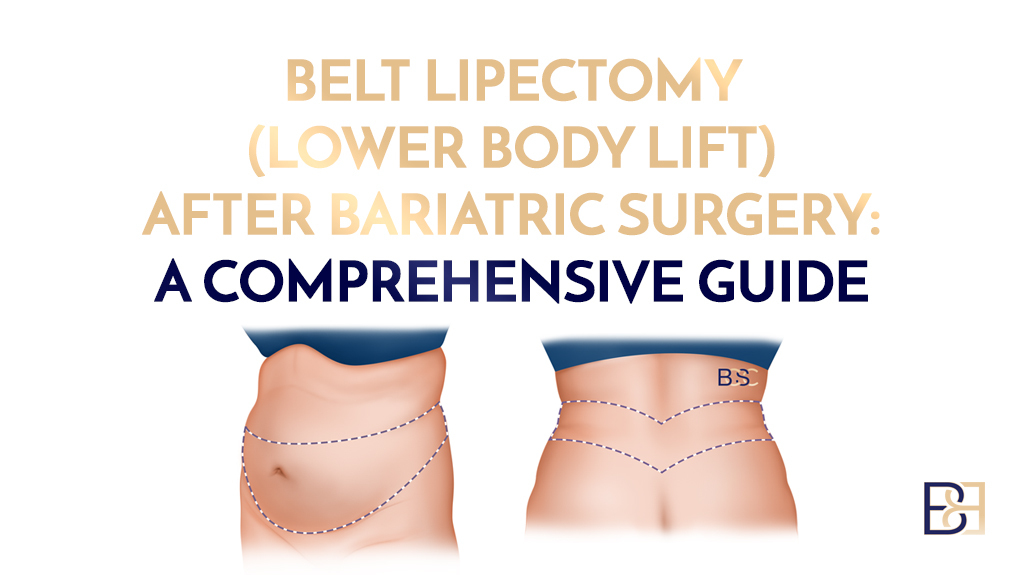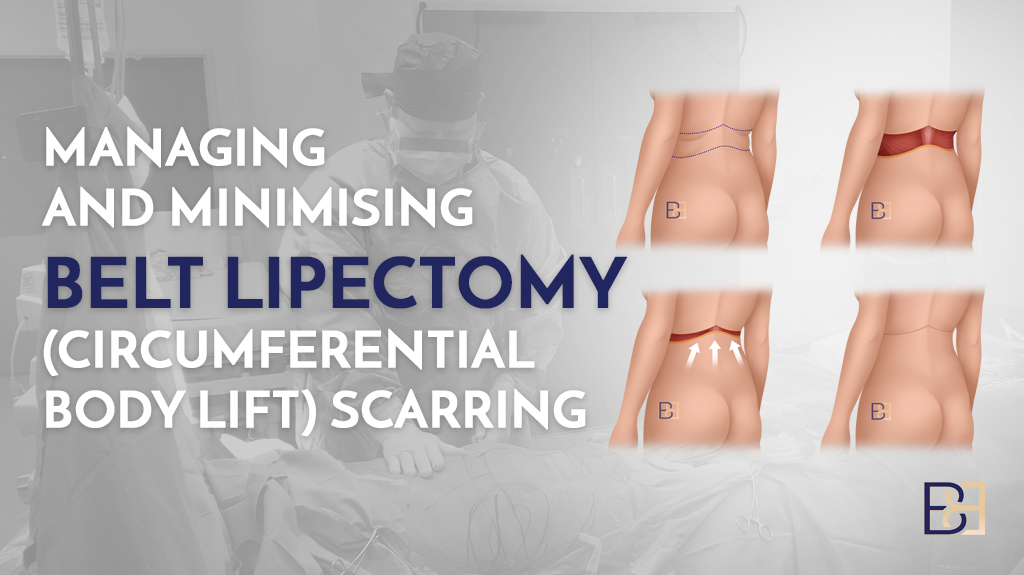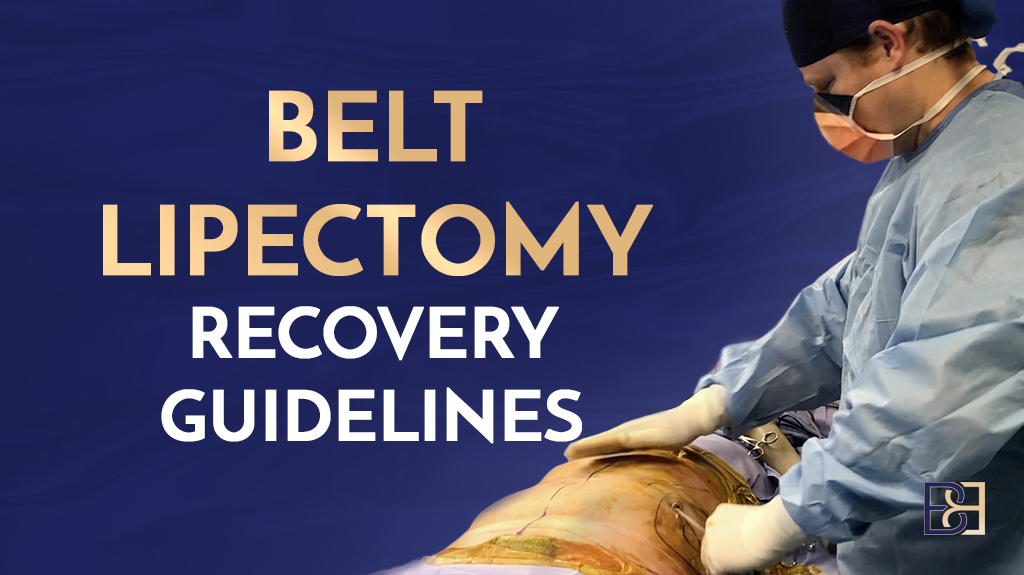If your goal is to eliminate excess skin and fat 360 degrees around your midsection after extreme weight loss, a belt lipectomy (lower body lift) procedure might be the next step. The only way to determine if you are a good candidate for a belt lipectomy is to meet with a specialist surgeon for a consultation. To learn what to expect during your belt lipectomy consultation and how to get the most out of your time in my office, along with cost and downtime considerations, continue reading.

Book your appointment online now
Ideal Belt Lipectomy Candidate
This surgical procedure might be for patients who have undergone significant weight loss, have loose skin and excess fat around the midsection, and are interested in treating their abdominal contours. It’s most commonly performed after weight loss surgery, but patients who have lost weight via traditional dieting and exercise and have maintained a stable weight will also qualify. One important note is that patients must have maintained a stable weight for at least six months to be considered for a belt lipectomy procedure.
Unlike a traditional abdominoplasty (tummy tuck plastic surgery), a belt lipectomy tightens loose skin on the tummy, mons pubis area, hips, lower back, and buttocks rather than only focusing on the abdomen. It can also tighten the inner and outer thighs to a limited extent.
If you’re considering this procedure, your next step is getting a referral from your GP and preparing for your belt lipectomy consultation.

What to Expect During a Belt Lipectomy Consultation
Review Personal Medical Information
During the consultation, we’ll go over your health history in detail, including known allergic reactions to medications, as well as any history of keloid scarring, blood disorders, past difficulty waking from anaesthesia, and major medical issues like heart problems or diabetes. These can all affect whether you can undergo elective surgery.
Discuss Surgical Expectations
Body lifts (Circumferential abdominoplasty) can have impressive results, but it’s important to have realistic expectations. Your preferences for circumferential scar placement and the body areas you want to focus on. Finally, even though this surgical procedure can remove fat that remains after weight loss, it isn’t a substitute for bariatric surgery or dieting. You’ll also need to stay active and eat well after healing from your surgery to maintain results.
Go Over Past Surgeries
During your consultation, you’ll be asked to disclose any past surgeries. Perhaps you’ve had bariatric surgery and are still in the process of losing weight. Maybe you’ve had medical devices implanted that can affect whether you can have an operation. Or, you could have had a bad reaction to general anaesthesia in the past. We will discuss all of this as part of your medical history review.
Review Lifestyle: Career, Family Life, Habits
The more complete a picture of your life you provide to me, the more accurately I can determine whether a major operation like a belt lipectomy is a good choice for you.
For example, can you take time off from work to recover? How physically demanding is your job? Do you live with family members who can help look after you in the first few weeks of your recovery? Do you live alone or do your loved ones live nearby to assist you? If needed, could you hire a caregiver for a few days or weeks as you heal? Do you have young children that rely on you? Can you arrange transportation for the first three to four weeks of the recovery period while you can’t drive?
These are just a few questions we should discuss during your office visit.
Lastly, your lifestyle habits will factor into your decision to have body contouring surgery. Ask yourself whether you are committed to a healthy lifestyle post-surgery to maintain your results. If you’re a smoker, are you willing to quit for at least six weeks before the procedure and continue refraining from smoking after the operation? You won’t be able to have a belt lipectomy if you continue to smoke.
Equally important is whether you can take six to eight weeks away from your exercise routine to heal. The more honest you are with yourself and me about these lifestyle questions, the better.
Discuss Alcohol, Nicotine, and Drug Use
Alcohol, medications, nicotine, recreational drugs, and even your daily multivitamins can all affect whether it is appropriate for you to have a belt lipectomy. It’s important to be honest about these issues or you could suffer the consequences.
For even more detailed information about the Belt Lipectomy Procedure, read my related article Your Complete Guide to Belt Lipectomy (Lower Body Lift) Surgery After Weight Loss.

Dr. Beldholm’s Comprehensive Consultation Process
Here is what to expect during your consultation with me.
Health Assessment
Together, we will comb through your personal and family medical history. If you have medical issues such as controlled diabetes or cardiovascular disease, for example, I will need to confirm that you’re well enough for a belt lipectomy and whether you are seeking to have this procedure for cosmetic reasons or medical concerns. Additionally, it’s important to bring any mental health issues to my attention.
Discuss Surgical Options
A belt lipectomy is fully customised for you. I’ll discuss options for your individualised surgical plan such as VASER liposuction (Suction-assisted lipectomy), umbilical hernia surgery, and abdominal muscle repair with you depending on what is needed to achieve your goals.
If you’re planning to have other surgeries to remove loose skin and tissue from other areas such as arms (brachioplasty) or thighs (thighplasty), or whether you’re interested in a breast lift (mastopexy) or gynaecomastia (male breast reduction), I will also help you decide how and when to undergo these procedures. Many times, I advise patients desiring to focus on multiple concerns to do so in two or more stages as the belt lipectomy itself involves an extended amount of time under general anaesthesia. We will discuss all of this at your consultation.

Tattoo (upper back) and face blurred for privacy
Disclaimer: Operation performed by Dr Bernard Beldholm. Adult content, surgery has risks; individual results vary, seek 2nd opinion. Please see the full disclaimer.
Take Photos
You’ll be asked to point to the body areas you want to focus on.
I will then take “before” photos in my office that can be used as a comparison after the surgery, should you decide to go ahead with it. The “before” photos are also a guide to help me plan the operation by making it easier to visualise issues such as asymmetry and zones with excess skin and fat.
Devise a Treatment Plan
Once we settle on the type of body contouring procedure that makes the most sense for you, I will design a surgical plan with your specific needs and goals in mind. Together, we will discuss your operation, step-by-step, so you know exactly what to expect.
Review Cost Considerations
After finalising your surgical plan, you’ll receive price quotes for the entire procedure, including my fee, the anaesthetist’s fee, and hospital charges. These are all billed separately.
A belt lipectomy is a big expense, so consider your financial situation carefully.
You may pay less out-of-pocket if you have top-tier private healthcare coverage and/or qualify for the Medicare Benefits Schedule Item Number for a belt lipectomy.
Discuss Downtime Involved
The initial recovery period requires a downtime of at least three weeks post op on average and up to eight weeks off of vigorous exercise. You’ll have to consider whether you can take time off work, driving, childcare, and the gym.
Review Risks of Belt Lipectomy Surgery
Complications can happen during or after any surgery. I’ll review the risks of belt lipectomy surgery so you can make an educated decision. Some risks we will discuss at your consultation may include:
- Infection
- Scarring
- Seroma
- Hematoma
- General Anaesthesia Complications

Elements of a Successful Consultation
A relaxed, modern environment and great communication between patient and surgeon set the foundation for a successful surgery journey.
Knowing What to Expect From Your Consultation
Your first consultation with me will take one hour. During this time, I will review your medical history and have you show me your body areas of concern. I will take your before photos and let you know if a belt lipectomy or another procedure is appropriate. I’ll explain how the operation works, how to prepare for your surgery, and what to expect as you recover. You’ll have time to ask me questions at the end.
A Relaxed Environment
My consultations are designed to help you get the information you need to decide whether to have body contouring surgery. You won’t be pressured to make a decision that day, but we can get the process started if you feel certain you’d like to move forward.
Remember, it is okay to take your time making a decision, whether that is days, weeks, or months. It’s also a good idea to ask for input from trusted loved ones as your decision to have a major surgery can impact their lives as well.
Honest Communication
Clear communication is essential for getting the most out of your consultation. As your surgeon, I will be honest and detailed about what the surgery can and can’t do for you. As a patient, your role is to be equally honest and communicate clearly about your body contouring goals.
Good communication on both our parts will allow me to design a surgical plan that ideally fits your needs and goals.(Ref 3).
Coming Prepared With Questions
In the days leading up to your consultation, it’s a good idea to write a list of questions you want to ask me.

Book your appointment online now
What To Ask Dr. Bernard During a Consultation
A belt lipectomy after weight loss is a serious decision. As such, you will probably have lots of questions to ask. Your consultation will have plenty of time built in to go over everything. If we run out of time, you are welcome to book a second or third consultation with me at no extra charge.
#1: Do I qualify for a belt lipectomy?
Losing a substantial amount of weight can leave you with excess skin and fat in several body areas. I offer many different body contouring surgeries to correct excess skin and fat. I can help guide you as you decide which surgical procedure is right for you during your consultation.
#2: What are the criteria to qualify for this procedure?
You might qualify for a belt lipectomy if you meet the following criteria:
- You don’t smoke.
- You have lost 30+ kilos.
- You are close to your goal weight.
- You have realistic expectations and goals.
- You have kept your weight stable for six months.
- You are in good health, both physically and mentally.
- You have loose skin on your abdomen, hips, lower back, thighs, and buttocks.
- You aren’t pregnant, nursing, or planning to become pregnant in the next year.
If you plan to apply for a Medicare rebate for belt lipectomy surgery, these criteria apply:
- Your excess skin is affecting your ability to perform daily activities. Ref 2
- Weight loss after pregnancy won’t count toward your BMI points lost. Ref 2
- You’ve lost at least five BMI units and maintained a healthy weight for six months or longer. Ref 2
- You have a skin condition such as intertrigo that hasn’t subsided after three months of non-surgical treatment. Ref 2
- You have photographic evidence and medical records from your doctors to support your claim for the MBS Item Number for belt lipectomy surgery.
#3: What is the cost of a belt lipectomy?
One of the most common questions patients ask is, ‘How much does a belt lipectomy cost?’ To answer this, you’ll need to come in for a consultation since it’s a customisable service. Most surgeons charge between $20,000 to 35,000 AUD, although surgeon’s fees can vary. You can lower the out-of-pocket costs if you qualify for a Medicare rebate and have gold-level private health insurance.
#4: Do you have photographic evidence and past medical records to support your Medicare claim?
If you are interested in applying for a Medicare rebate for your belt lipectomy surgery, you must be able to show you need the operation for medical reasons. For example, Medicare will want to see photographs of any chronic skin irritation such as rashes that you have had as a direct result of excess skin. You’ll also need supporting documents from any doctors you’ve seen during your weight loss journey to support your claims.
#5: What is the standard recovery process?
For starters, I advise my patients to plan for a three to five day hospital stay as the first week of recovery can be quite difficult. You’ll be sore and may have difficulty walking upright, but with each passing day, things should get a little easier.
Generally speaking, most patients return to work and drive within three to four weeks and resume exercising after six to eight weeks. But, every patient’s recovery experience is unique. Factors such as the degree of physical exertion your job requires play into how soon you’ll reach these milestones.
Though it may not seem it at the time, before you know it, you should feel like yourself again, although it can take a few months to feel 100 percent.
#6: Are there complications associated with a belt lipectomy?
Anyone undergoing this surgery should know that risks and side effects are possible, even if you choose an experienced surgeon and follow all your aftercare instructions. With my liposuction (Suction-assisted lipectomy) assisted belt lipectomy technique, easily treated, minor complications are more likely to occur than serious ones (Ref 1).
Some risks to consider are infections, blood clots, excessive bleeding, changes in skin sensation, an allergic reaction to medications, fluid buildup that requires draining, an opened incision, heart or lung problems, and keloid scars. Complications are less likely if you avoid smoking and follow my medical advice before and after your operation.
During your consultation, I’ll go over all the risks with you. You’re welcome to ask me questions. You will also receive an electronic or paper document describing all the risks to take home with you.

Dr. Beldholm’s Final Thoughts
In the last 15 years, I’ve performed countless belt lipectomies and other excess skin removal surgeries for post-weight-loss patients. It’s a field I’m truly passionate about, and it would be my pleasure to help you decide if belt lipectomy surgery after weight loss is right for you. If you’re ready to take the next step, book a consultation to learn more about your surgical options.
FAQs
What counts as massive weight loss?
The Medicare definition for significant weight loss is the loss of 5 BMI points (not related to pregnancy). A belt lipectomy procedure is commonly performed on people who have excess tissue after losing 30+ kilos. The weight loss is usually unrelated to pregnancy. Instead, it’s designed for those with a significant amount of excess skin all around their belt line after bariatric surgery or lifestyle changes.
What’s the difference between an abdominoplasty and a belt lipectomy procedure?
An abdominoplasty tightens loose skin on the abdomen and brings separated abdominal muscles back together if they have loosened. A belt lipectomy procedure is similar to a tummy tuck (abdominoplasty) in that it helps to tighten stretched skin on the abdomen. However, it has a longer incision that allows me to remove excess skin on the front, back, and sides of the lower torso. A belt lipectomy is a bigger operation since it involves the abdomen, bum, thighs, mons pubis and flanks. After a thorough consultation, I’ll let you know which procedure is better suited to you.
What are some reasons for removing excess skin and tissue?
There are many reasons a person who has undergone significant weight loss might want to remove loose skin from the abdominal region and other areas. Skin folds can cause skin irritation, discomfort, and make clothing fit poorly. If you have a significant amount of loose skin, it could affect your mobility or hygiene.
What are some other names for this procedure?
A belt lipectomy is sometimes called a circumferential body lift, lower body lift, or circumferential abdominoplasty, 360 abdominoplasty.
Are there any risks I should know about?
Surgically removing extra skin carries risks. Some possible belt lipectomy complications include excess fluid that needs to be drained, a blood clot in the legs, changes in skin sensation, unsightly circumferential scarring, pulmonary embolism, asymmetrical results, poor wound healing, infections, wound separation, or adverse reactions to general anaesthesia. Circumferential abdominoplasty is slightly riskier than a traditional abdominoplasty since it involves operating on more areas of the body. Patients who are physically fit and don’t smoke are less likely to have major complications.
How soon will I see my surgical results?
It takes time for the swelling to resolve and for the scar to mature. Expect to see your final surgery results approximately one year after your operation.
Do belt lipectomies remove unwanted fat?
This procedure will remove subcutaneous fat that underlies the skin that is removed. I often add VASER liposuction (Suction-assisted lipectomy) to the procedure to remove excess fat and refine the contours of the abdominal wall, sides, back, and buttocks as needed.
References
- Bertheuil, Nicolas, et al. “The Lipo–Body Lift.” Plastic and Reconstructive Surgery, vol. 139, no. 1, Jan. 2017, pp. 38e49e, https://doi.org/10.1097/prs.0000000000002926. Accessed 24 Nov. 2022.
- Medicare Benefits Schedule – Item 30177.” Item 30177 | Medicare Benefits Schedule, www9.health.gov.au/mbs/fullDisplay.cfm?type=item&qt=ItemID&q=30177. Accessed 25 Jul 2024.
- Sugai, Daniel Y, et al. “The Importance of Communication in the Management of Postoperative Pain.” Hawai’i Journal of Medicine & Public Health, vol. 72, no. 6, 1 June 2013, pp. 180–184, www.ncbi.nlm.nih.gov/pmc/articles/PMC3689499/.





